Abstract
Soybean sprouts are among the healthiest foods consumed in most Asian countries. Their nutritional content, especially bioactive compounds, may change according to the conditions of germination. The purpose of this study was to test the effect of chitooligosaccharide with different molecular weight and dosage on nutritional quality and enzymatic and antioxidant activities of soybean sprouts. The chitooligosaccharide elicitor strongly stimulated the accumulation of vitamin C, total phenolics, and total flavonoid. The stimulation effect was correlated with the molecular weight and concentration of chitooligosaccharide. With treatment of 0.01% of 1 kDa chitooligosaccharide, the nine phenolic constituents and six isoflavone compounds were significantly increased. The antioxidant capacity (DPPH radical and hydroxyl radical scavenging activity) and antioxidase activities (catalase and peroxidase) of soybean sprouts were also enhanced after treatment with chitooligosaccharide. The degree of chitooligosaccharide-induced elicitor activity increased as the molecular weight of chitooligosaccharide decreased. These results suggest that soaking soybean seeds in a solution of chitooligosaccharide, especially in 0.01% of 1 kDa chitooligosaccharide, may effectively improve the nutritional value and physiological function of soybean sprouts.
1. Introduction
As a major source of protein, soybean has been one of the most important crops in China since more than five thousand years and nowadays often appears in Western diets [1]. Soybean has high nutritional value and is recognized as a functional food that both promotes health and has therapeutic effects [2]. For example, soybean contains a high concentration of isoflavones, which are indicated to have benefits in reducing risk of multiple diseases, such as hormone-dependent cancers, and age-related cognitive decline [3]. Soybean is also believed to have antioxidant activity, due to its high amount of total phenolics, that may help neutralize harmful free radicals and reduce the risk of degenerative diseases [4].
Germination technology, which is an inexpensive and effective method, was applied to improve the taste and enhance the nutritional value of soybean [5]. During germination, the endogenous enzymes in soybean are activated and storage nutritional compounds are converted to bioactive components. As a result, the nutrient levels, bioavailability, and palatability are improved [6]. For example, vitamin C, which is famous for its physiological functions in animals and plants, barely exists in soybeans and significantly increases in soybean sprouts. Most importantly, germination is conducive to the accumulation of phenolics and flavonoids, which have antioxidant activity [7]. Furthermore, the sprouts of soybeans have been shown to be effective as an anti-hypertensive diet [8]. At the same time, germination can reduce or remove anti-nutritional factors in soybean, such as a-galactoside, trypsin inhibitor, phytic acid, lectin, and lipase inhibitor [9]. Germination technology expands the application of soybean in food processing and improves its utilization value.
Most of the functional ingredients in plants are secondary metabolites, which are biosynthesized as a defense response to different stresses. Hence, the accumulation of secondary metabolites may be stimulated by various elicitors [10]. Chitosan (poly [β-(1-4)-2-amino-2-deoxy-d-glucopyranose]) is an environmentally-friendly and biocompatible cationic polysaccharide, which is obtained by partially deacetylated chitin extracted from naturally occurring crustacean shells [11]. Studies have shown that chitosan can elicit defense responses with respect to callose formation, phytoalexin induction, and lignification [12]. Chitosan can also be employed in the treatment of soybean to enhance the yield and quality of soybean sprouts [13,14]. According to Lee et al., chitosan effectively increased the growth of soybean sprouts without adverse effects on the nutritional and postharvest characteristics [15]. Recently, Yang et al. reported that chitosan pre-soaking could improve the growth and quality of yellow soybean sprouts during germination, dependent on concentration [16]. However, application of chitosan is limited due to its poor solubility under physiological conditions. Recent studies showed that the hydrolytic product of chitosan, a water-soluble chitooligosaccharide, also has elicitor activity in seed germination [17]. Furthermore, chitooligosaccharide has a great advantage when utilized as antimicrobial agents, antioxidants, and enhancers of the nutritional quality of food, while molecular weight is identified as a main characteristic of chitooligosaccharide that is closely associated with the biological activity of the latter [18]. However, few reports to date have investigated the role of chitooligosaccharide as an elicitor in improving the quality of soybean sprouts, especially their phytochemicals, enzymatic, and antioxidant activities.
In the present study, we evaluated the elicitor effects of chitooligosaccharide on phytochemicals, enzymatic, and antioxidant activities of germinated soybean. To the best of our knowledge, this is the first report on the application of chitooligosaccharide as an elicitor in improving the quality of soybean sprouts. The results show that chitooligosaccharide could increase the concentration of bioactive compounds including vitamin C, phenolics, and isoflavones. In addition, the activities of catalase and peroxidase as well as free radical scavenging-linked antioxidant activities of soybean sprouts were improved significantly. Data from this study would be valuable for the production of high-quality and chemical-free soybean sprouts to satisfy consumers’ demands.
2. Materials and Methods
2.1. Plant Material, Chitooligosaccharide, and Chemicals
Commercial soybeans (Glycine max L.) were purchased from the Walmart supermarket, Dalian city, China. Chitooligosaccharide with different molecular weights (1, 2, and 3 kDa) and a deacetylation degree of 70% were purchased from Golden-Shell Pharmaceutical Co. (Wenzhou, China). Gallic acid, protocatechuic acid, syringic acid, p-coumaric acid, vanillic acid, ferulic acid, ellagic acid, cinnamic acid, p-hydroxybenzoic acid, genistein, daidzein, glycitein, genistin, daidzin, and glycitin were purchased from Yuanye Bio-Technology Co. (Shanghai, China).
2.2. Soybean Germination
Soybean seed (40 g) was washed three times and soaked in 100 mL distilled water at room temperature for 3 h. After soaking, seeds were placed into the sprouter (Fumin, modelFMC-30B, Qingzhou, China) and kept in the dark at 25 °C for germination. The soybean sprouts were rinsed with tap water every 12 h. The sprouts were harvested after 3 days of treatment.
2.3. Chitooligosaccharide Treatment
Three different molecular chitooligosaccharides (1 kDa, 2 kDa, and 3 kDa) were dissolved in distilled water to give a final concentration of 0.001%, 0.01%, 0.1%, and 1.00% (w/v), and they were used as soaking solution treatments. After 3 h of soaking, seeds were washed thoroughly with distilled water and placed into the sprouter for germination.
2.4. Determination of Vitamin C
Vitamin C content of soybean sprouts was determined using 2, 6-dichloroindophenol titrimetric method [19]. Briefly, 20 g of fresh sprouts were ground in a mortar with 40 mL of chilled 2% (w/v) metaphosphoric acid buffer, and then adjusted to 100 mL. After filtration, 10 mL filtrate was titrated with 0.1% (w/v) 2, 6-dichloroindophenol, and the color of the titration end-point was light red. Ascorbic acid was used as a quantitative standard. The content of vitamin C was expressed as mg per 100 g of fresh weight.
2.5. Phytochemical Extraction
After harvest, the sprouts were freeze-dried and ground with a sample mill (Jiuyang, modelJYL-C16V, Jinan, China) and passed through an 80-mesh sieve. An amount of 5 g of ground sprout powder was added to 100 mL of an 80% (v/v) methanol solution and extracted at 25 °C and 260 rpm for 3 h. The homogenate was centrifuged at 10,000 rpm for 10 min at room temperature. The supernatant was collected and used for determination of phytochemical content and antioxidant tests.
2.5.1. Determination of Total Phenolics Content
A volume of 100 µL of the sample extract was mixed with 400 µL of distilled water. An amount of 100 µL of a Folin–Ciocalteu reagent was added and left for 6 min. Next, an aliquot of 1 mL of a 7% (w/v) Na2CO3 solution was added, and then the mixture adjusted to 3 mL with distilled water. Samples were incubated for 90 min at room temperature, and measured at 760 nm against the blank using a spectrophotometer (Molecular Devices, model SpectraMax Plus 384, San José USA). A standard curve was prepared with known gallic acid concentrations. The content of total phenolics was expressed as mg/g of dry weight.
2.5.2. Determination of Total Flavonoid Content
An amount of 0.25 mL of the sample extract was added to 1.25 mL of distilled water, followed by the addition of 75 µL of a 5% (w/v) NaNO2 solution. After 6 min, 150 µL of a 10% (w/v) Al(NO3)3·9H2O solution was added and incubated for another 5 min before 0.5 mL of 1 M NaOH was added. Distilled water was added to adjust the final volume to 2.5 mL. The absorbance of the mixture was measured immediately at 510 nm and compared with standards prepared with known (+)-catechin concentrations. Results were expressed as mg/g of dry weight.
2.5.3. HPLC Analysis of Phenolic Components and Isoflavones
Phenolic components were determined by HPLC with a Poroshell 120 EC-C18 column (4.6 × 250 mm, 4 µm particle size) (Waldbronn, Germany) and ultraviolet detector. The mobile phase consisted of acetonitrile (A) and 0.3% (v/v) acetic acid (B). Flow rate was 0.6 mL/min, column temperature was 40 °C, and detection wavelength was 254 nm. The gradient elution process began with the mobile phase A at 20% in the first 5 min, then increased from 20% to 90% for the next 5 min, while in the following 5 min it reduced from 90% to 10%, and increased to 20% A in the last 10 min. The peaks of the samples were identified based on the retention times of the standards and the concentrations of phenolics were calculated from standard curves. The concentration was expressed as mg/g of dry weight.
Isoflavones were quantified using the same column and chromatographic conditions as described above, while the two solvents used in the mobile phase were solvent A, 0.1% (v/v) acetic acid, and solvent B, methanol. The gradient elution process began with the mobile phase A from 5% to 30% in the first 50 min, and then increased from 30% to 100% for the next 15 min, and the last 15 min was 100% A. The concentrations of isoflavones in the sample were calculated from standard curves of different isoflavone standards, and it was expressed as mg/g of dry weight.
2.5.4. Analysis of DPPH Radical Scavenging Activity
The 2, 2-diphenyl-1-picrylhydrazyl (DPPH) radical scavenging activity was examined using the DPPH method [20]. Briefly, 0.1 mL of the sample extract was mixed with 2.9 mL DPPH in ethanol (100 µM) and incubated in the dark at 33 °C for 30 min. The absorbance of the mixture was measured at 517 nm and denoted Ai. A control sample was obtained by mixing 0.1 mL ethanol with 2.9 mL DPPH solution (100 µM) and its absorbance value was denoted A0. A reference test was carried out by adding 0.1 mL of the sample extract to 2.9 mL ethanol, and Aj referred to the absorbance of the resultant solution. The DPPH radical scavenging activity was expressed as a scavenging rate and calculated as follows: DPPH scavenging rate (%) = [1 − (Ai − Aj)/A0] × 100%.
2.5.5. Analysis of Hydroxyl Radical Scavenging Activity
1.0 mL H2O2 (7.5 mM) was mixed with a solution containing 0.2 mL ammonium ferric sulfate (0.75 mM), 0.2 mL 1, 10-phenanthroline (0.5 mM), 1.0 mL sample extract, and 1.0 mL Tris buffer (500 mM, pH 7.4). The reaction mixture was adjusted to 10 mL with distilled water and incubated at 37 °C for 1 h. After cooling, the absorbance of the samples was measured at 508 nm and denoted As. The absorbance of the control without sample extract was denoted Ac. The absorbance of the reference without the sample extract and H2O2 addition was denoted A0. The hydroxyl radical scavenging activity was expressed as a scavenging rate and calculated as follows: hydroxyl scavenging rate (%) = (As − Ac)/(A0 − Ac) ×100%.
2.6. Enzyme Assays
Catalase was determined by following the consumption of H2O2 [21]. An amount of 5 g of fresh sprouts was suspended in 20 mL phosphate buffer (0.1 M, pH 7.8) ground into homogenate and adjusted to a final volume of 100 mL. The homogenate was centrifuged at 10,000 rpm and 4 °C for 15 min and the supernatant was collected and used for enzyme assay. An amount of 0.3 mL of H2O2 (0.1 M) was added to a solution containing 0.2 mL enzyme extract and 2.5 mL phosphate buffer (0.1 M, pH 7.8). Immediately after mixing, the concentration of H2O2 was measured spectroscopically at 240 nm at 10 s intervals for up to 3 min. One unit of activity was defined as the amount of enzyme that catalyzes the degradation of H2O2 leading to a decrease of 0.1 in the absorbance at 240 nm per minute under the above experimental conditions. The control experiment was carried out with boiled enzyme under the same conditions.
Peroxidase was evaluated with guaiacol in the presence of H2O2 [21]. The enzyme extraction from soybean sprouts was performed as described above for catalase assay. An amount of 0.1 mL of enzyme extract was added to a solution containing 2.9 mL of 0.4% H2O2 and 1 mL of 0.05 M guaiacol in 0.1 M phosphate buffer (pH 5.5). The increase in the absorbance of the mixture was monitored at 470 nm for 3 min. The control experiment was carried out with boiled enzyme. One unit of enzyme activity was defined as the amount of enzyme that catalyzes the oxidation of guaiacol leading to a 0.01 increase in the absorbance at 470 nm per minute under the above experimental conditions.
2.7. Statistical Analysis
All tests were conducted in triplicate and data were reported as the mean ± standard deviation. Significant differences among means were tested by one-way analysis of variance using SPSS software (SPSS, Chicago, IL, USA). Duncan’s multiple range test was used to compare the differences of means among different groups, and differences with p < 0.05 were considered statistically significant.
3. Results and Discussion
3.1. Vitamin C Content
Vitamin C plays an important role in the process of collagen synthesis in humans. Because humans are unable to synthesize vitamin C, fresh fruit and vegetables are needed as a supplement of vitamin C [1]. As a result, soybean sprouts have attracted people’s attention for their high content of vitamin C. Figure 1 presents the vitamin C content in soybean sprouts that have been treated with chitooligosaccharides of different molecular weights at different concentrations. It can be found that chitooligosaccharide could effectively promote the vitamin C accumulation in soybean sprouts, and all the different chitooligosaccharide treatments revealed higher vitamin C content than the control. The vitamin C content of soybean sprouts was increased by 45.84% with 0.001% of 1 kDa chitooligosaccharide. When the concentration of chitooligosaccharide increased to 0.01%, the vitamin C content reached the maximum, 33.33 mg/100 g fresh weight, about 2.11-fold in comparison with the control of 15.83 mg/100 g fresh weight. However, after treatment with 0.1% and 1% of 1 kDa chitooligosaccharide, the vitamin C content decreased to 29.17 mg/100 g and 24.67 mg/100 g, which were still more than the control. There was a similar trend for the treatment with 2 kDa and 3 kDa chitooligosaccharide. After treatment with 0.01% of 2 kDa and 3 kDa chitooligosaccharide, the vitamin C content of soybean sprouts increased to 30.83 mg/100 g fresh weight and 27.35 mg/100 g fresh weight, respectively.
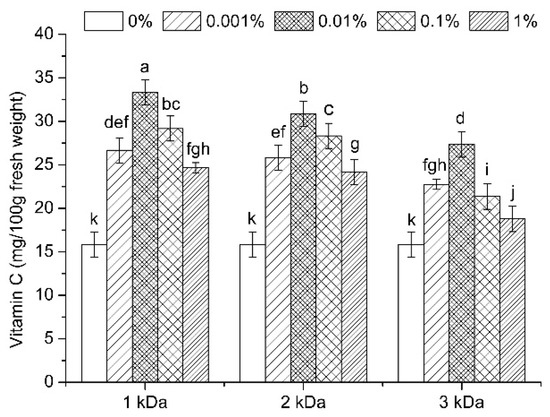
Figure 1.
Vitamin C content of soybean sprouts under different chitooligosaccharide treatments. The treatments were conducted with chitooligosaccharides of three molecular weights (1, 2, and 3 kDa) at four different concentrations (0.001 to 1%). The control treatment (0%) included the same solutions without chitooligosaccharides. Vertical bars represent the standard error of three replicates. Different letters indicate statistically significant difference (p < 0.05).
As an important bioactive component, vitamin C does not exist in soybeans but increases after germination. This is owing to a response in the environmental factors [16]. Chitosan and chitooligosaccharide are well documented plant defense elicitors and are recognized as stress signals by plant cells [22]. It has been discovered that the size and dosage of chitooligosaccharide are crucial in determining their elicitor activity [6].
In the present study, the vitamin C content (15.83 mg/100 g fresh weight) of the control was similar to that (15.82 mg/100 g fresh weight) reported by NO and others. However, after treatment with 0.01% of 1 kDa chitooligosaccharide, the highest vitamin C content of soybean sprouts increased to 33.33 mg/100 g fresh weight, which was significantly higher than their treatment with 0.1% of 493 kDa chitosan (17.01 mg/100 g fresh weight) [13]. This result was in accordance with previous studies, which showed that the antiviral activity of chitosan increased as its molecular weight decreased. The highest activity was exhibited by the fractions with Mw = 2.2 and 1.2 kDa [23].
3.2. Total Phenolics Content
It has been proven that tremendous changes in functional substances are closely linked to germination of soybeans, such as high phenolics content [4]. Additionally, chemical elicitors can significantly increase the phenolics content in bean sprouts [24]. In this study, total phenolics content of soybean sprouts in all treatments with chitooligosaccharide was shown in Figure 2. Overall, the phenolics content of soybean sprouts was significantly increased by the chitooligosaccharide in three molecular weights (1 kDa, 2 kDa, and 3 kDa). The smallest molecular weight led to the highest increase in phenolics under the same treatment concentration. Total phenolics content increased gradually along with the increase in chitooligosaccharide until 0.01%, and after that it gradually reduced. Soybean sprouts treated with 0.01% of 1 kDa chitooligosaccharide exhibited the highest phenolics content of 25.60 mg/g dry weight, which was approximately 28% higher than that of the control. The total phenolics content of soybean sprouts treated with 0.01% of 2 kDa and 3 kDa chitooligosaccharide increased by 23% and 20%, respectively. These results were similar to the increase in phenolics as a result of ethephon treatment [25]. Compared with ethephon, chitooligosaccharide is safe and environmentally friendly, so it can be a useful alternative in increasing phenolic secondary metabolites in soybean sprouts.
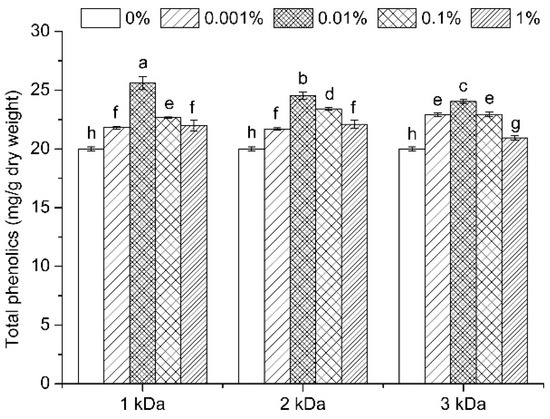
Figure 2.
Total phenolics content of soybean sprouts under different chitooligosaccharide treatments. The treatments were conducted with chitooligosaccharides of three molecular weights (1, 2, and 3 kDa) at four different concentrations (0.001 to 1%). The control treatment (0%) included the same solutions without chitooligosaccharides. Vertical bars represent the standard error of three replicates. Different letters indicate statistically significant difference (p < 0.05).
3.3. Total Flavonoid Content
Germination could increase the flavonoid content, which might be owing to the activation of enzymes involved in the biosynthesis of flavonoids from large molecular weight polyphenols such as tannins [26]. Flavonoids contain a diverse group of phytochemicals with antioxidant and anticancer activity, and they have been detected in fruits, vegetables, tea, and wine [27,28]. In order to clarify the effects of chitooligosaccharide on the flavonoid’s accumulation of soybean sprouts, soybeans were treated with chitooligosaccharide before germination. As shown in Figure 3, similar to the changing trend of vitamin C and total phenolics, the total flavonoid content of soybean sprouts was efficiently increased by all chitooligosaccharide elicitors with a molecular-weight-dependent mode. Among them, 1 kDa chitooligosaccharide was the most effective elicitor, and when using it in the concentration of 0.01%, the flavonoids content of soybean sprouts was 1.25 mg/g dry weight, about 22% more than that of the control (1.03 mg/g dry weight). Chitooligosaccharide with the molecular weight of 2 kDa and 3 kDa had a similar promoting action, and they improved the accumulation of flavonoids to 1.21 mg/g dry weight at a concentration of 0.01%. These results are consistent with earlier findings which showed that chitosan could induce the stimulation of secondary metabolism of plants [29].
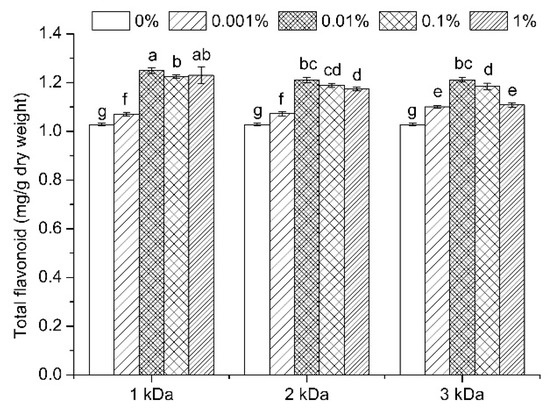
Figure 3.
Total flavonoid content of soybean sprouts under different chitooligosaccharide treatments. The treatments were conducted with chitooligosaccharides of three molecular weights (1, 2, and 3 kDa) at four different concentrations (0.001 to 1%). The control treatment (0%) included the same solutions without chitooligosaccharides. Vertical bars represent the standard error of three replicates. Different letters indicate statistically significant difference (p < 0.05).
3.4. Quantification of Phenolic Components
Phenolic compounds are generally secondary metabolites with high antioxidative and antiaging properties, and they are beneficial to human health [30]. Khang and others have found several phenolic compounds in soybean sprouts including gallic acid, protocatechuic acid, syringic acid, p-coumaric acid, vanillic acid, ferulic acid, ellagic acid, cinnamic acid, p-hydroxybenzoic acid, and sinapic acid [4]. The impacts of chitooligosaccharide on nine of these phenolic compounds in soybean sprouts were studied (Table 1). Concentrations of phenolic components from different treatments differed significantly (p < 0.05). The contents of gallic acid ranged from 18.698 to 32.274 mg/g dry weight, protocatechuic acid from 0.539 to 1.444 mg/g dry weight, syringic acid from 0.073 to 0.116 mg/g dry weight, p-coumaric acid from 0.771 to 1.460 mg/g dry weight, vanillic acid from 1.021 to 1.844 mg/g dry weight, ferulic acid from 4.845 to 7.398 mg/g dry weight, ellagic acid from 0.459 to 0.775 mg/g dry weight, cinnamic acid from 0.053 to 0.254 mg/g dry weight, and p-hydroxybenzoic acid from 0.251 to 2.646 mg/g dry weight. All the phenolics were significantly increased in the presence of chitooligosaccharide, and the most effective treatment was 1 kDa chitooligosaccharide with the concentration of 0.01%. These results were in accordance with the total phenolics content measurement. Among them, p-hydroxybenzoic acid showed the highest proportion of increase, which was about 10.54-fold over the control. The contents of cinnamic acid and protocatechuic acid increased to 4.79-fold and 2.68-fold in comparison with that of the control, respectively. In addition, the contents of gallic acid, syringic acid, p-coumaric acid, vanillic acid, ferulic acid, and ellagic acid in sprouts treated with the same chitooligosaccharide increased by 73%, 59%, 89%, 81%, 53%, and 69%, respectively. This clearly indicated that chitooligosaccharide was extremely effective in increasing phenolic secondary metabolites in soybean sprouts, and the increase in these phenolic compounds was the result of resisting oxidative stress [25]. However, in contrast with research by Khang [4], the contents of these phenolic compounds were much higher in our study. These discrepancies might be due to differences in soybean cultivars and germination methods.

Table 1.
Phenolic components concentration (mg/g dry weight) of soybean sprouts under different chitooligosaccharide treatments.
3.5. Quantification of Isoflavone Components
Numerous studies have confirmed that soybean isoflavones are effective cancer-preventive agents for lowering risks of various cancers [31]. Soybean isoflavones mainly exist in two forms: aglycon (genistein, daidzein and glycitein) and different types of glucosides (genistin, daidzin and glycitin). The aglycon form is the most biologically active isoflavone for mammal metabolism [6]. In the present study, six kinds of isoflavones were compared between different treatments (Table 2). Overall, chitooligosaccharide treatments induced statistically significant changes in their contents. Regardless of the molecular weight, all the promoting effects of chitooligosaccharide were dependent on its concentration. Treatment with an amount of 0.01% chitooligosaccharide increased the content of these six isoflavones in the soybean sprouts extract significantly. Among these elicitation treatments, 0.01% of 1 kDa chitooligosaccharide was the most effective one. The highest content of glycitein was 0.251 mg/g dry weight, which was about 20.92-fold compared with the control (0.012 mg/g dry weight) when the seeds were treated with 0.01% of 1 kDa chitooligosaccharide. After treatment with 0.01% of 2 kDa and 3 kDa chitooligosaccharide, the concentration of glycitein increased to about 18.33-fold and 19.67-fold in comparison with that of the control, respectively. There were also significant differences in the concentrations of genistein, daidzein, genistin, daidzin, and glycitin between the control and 0.01% of 1 kDa chitooligosaccharide treatments, and the contents of them increased by 16%, 6%, 62%, 90%, and 68%, respectively.

Table 2.
Isoflavone components concentration (mg/g dry weight) of soybean sprouts under different chitooligosaccharide treatments.
The observed impact of chitooligosaccharide on isoflavone concentrations was in accordance with previous studies, which reported that seed and foliar treatments of soybean plants with chitosan could bring about a significant increase in the concentration of daidzein, genistein, glycitein, as well as total isoflavone in soybean when compared with untreated control plants [32]. Furthermore, it is known that the biosynthesis of isoflavone is submetabolic, via the malonate and phenylpropanoid pathways [33]. Dixon and Paiva have reported that various biotic and abiotic stresses could stimulate the phenylpropanoid metabolism [34]. As a result, it is made clear that chitooligosaccharide has the eliciting activity in inducing the stress responses and secondary metabolism of soybean sprouts, and can be used as a harmless alternative to produce high quality soybean sprouts with a good market potential [35].
3.6. Antioxidant Activity Evaluation
It is believed that free radicals are directly related to various diseases, and dietary antioxidants, which are able to scavenge free radicals, may be used to reduce the risk of these diseases. Therefore, it is important to investigate the radical scavenging effect of antioxidants in soybean sprouts [2]. The most commonly used method is based upon the stable free radical DPPH [36]. In the present study, antioxidant activity was evaluated by scavenging capability of DPPH (Figure 4). Regardless of molecular weight and concentration, antioxidant activity in chitooligosaccharide-treated soybean sprouts was higher than the control, which could be the result of high total phenolics accumulation observed in the preceding section [37]. Among them, the smallest molecular weight led to the highest DPPH radical scavenging activity under the same treatment concentration. DPPH radical scavenging activity increased gradually along with the increase in chitooligosaccharide until 0.01%, and after that it gradually reduced. The soybean sprouts treated with 0.01% of 1 kDa chitooligosaccharide showed the strongest DPPH scavenging activity of 28.14%, which is about 1.83-fold compared with the control of 15.40%. The scavenging activity of soybean sprouts treated with 0.01% of 2 kDa and 3 kDa chitooligosaccharide were 23.71% and 21.83%, respectively. This clearly indicated that chitooligosaccharide-treated soybean sprouts have better free radical scavenging ability to protect the plant from oxidative damage [38]. However, the antioxidant activity of soybean sprouts was continuously decreased when the concentration of chitooligosaccharide was higher than 0.01%. These changes in antioxidant activity may confirm that if the concentrations of chitooligosaccharides were too high and oxidative stress was too high, then its stimulatory effect was weakened.
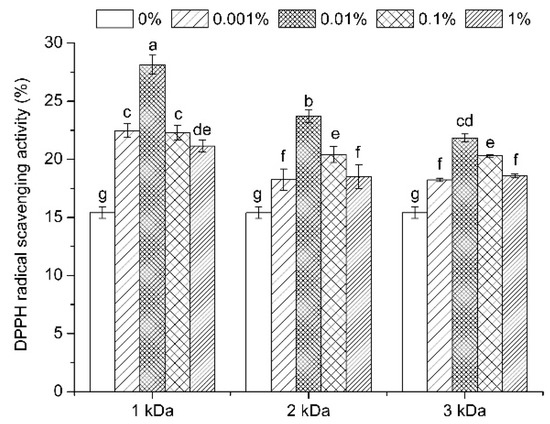
Figure 4.
DPPH radical scavenging activity of soybean sprouts under different chitooligosaccharide treatments. The treatments were conducted with chitooligosaccharides of three molecular weights (1, 2, and 3 kDa) at four different concentrations (0.001 to 1%). The control treatment (0%) included the same solutions without chitooligosaccharides. Vertical bars represent the standard error of three replicates. Different letters indicate statistically significant difference (p < 0.05).
Because hydroxyl radicals are so reactive that they can cause potential damage to cells [39], the hydroxyl radicals scavenging activity in chitooligosaccharide-treated soybean sprouts was also investigated. As shown in Figure 5, the hydroxyl radical scavenging activity of soybean sprouts was similar to the changing trend of the DPPH radical scavenging activity. An amount of 0.01% of 1 kDa chitooligosaccharide was the most effective one, which increased the hydroxyl radical scavenging activity of soybean sprouts to 64.33%, which is about 1.43-fold compared with the control. Treatments with 0.01% of 2 kDa and 3 kDa chitooligosaccharide also improved the hydroxyl radical scavenging activity of soybean sprouts, representing 33% and 28% increases, respectively. The enhancement in antioxidant activity of soybean sprouts treated with chitooligosaccharide demonstrated an improvement in their biological function, and these soybean sprouts may meet the needs of people looking for new drugs from food materials [40].
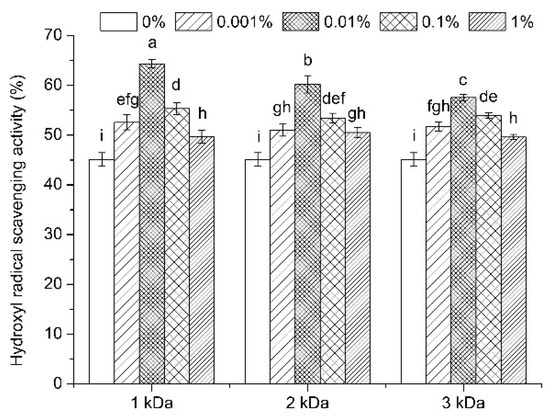
Figure 5.
Hydroxyl radical scavenging activity of soybean sprouts under different chitooligosaccharide treatments. The treatments were conducted with chitooligosaccharides of three molecular weights (1, 2, and 3 kDa) at four different concentrations (0.001 to 1%). The control treatment (0%) included the same solutions without chitooligosaccharides. Vertical bars represent the standard error of three replicates. Different letters indicate statistically significant difference (p < 0.05).
3.7. Enzymatic Activities
It is known that chitosan has the potential for inducing defense-related enzymes [41], so the enzymatic activities, including catalase and peroxidase, in soybean sprouts after treatments of chitooligosaccharide were studied. Results showing catalase activity of soybean sprouts in different treatments were presented in Figure 6. In general, the treatments of chitooligosaccharide depicted higher catalase activity, among which, the highest increase was treatment with 0.01% of 1 kDa chitooligosaccharide, and resulted with 185.55 U/g fresh weight. Treatments with 2 kDa and 3 kDa chitooligosaccharide had similar stimulation effects on the activity of catalase, and at a concentration of 0.01%, they improved the activity of catalase to 156.67 U/g fresh weight and 159.64 U/g fresh weight, respectively. Regardless of the molecular weight, chitooligosaccharide with a concentration higher or lower than 0.01% has less elicitor activity. Catalase can detoxify H2O2 to water, thereby reducing the damage of reactive oxygen species to plants. The increase in the activity of catalase was most likely a response to the increased generation of reactive oxygen species and indicative of oxidative stress [42].
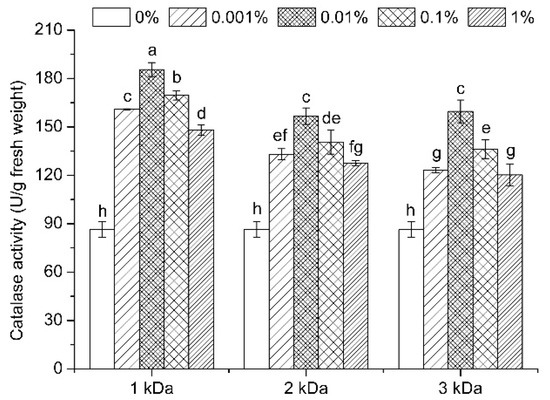
Figure 6.
Catalase activity of soybean sprouts under different chitooligosaccharide treatments. The treatments were conducted with chitooligosaccharides of three molecular weights (1, 2, and 3 kDa) at four different concentrations (0.001 to 1%). The control treatment (0%) included the same solutions without chitooligosaccharides. Vertical bars represent the standard error of three replicates. Different letters indicate statistically significant difference (p < 0.05).
Peroxidase is involved in a variety of physiological functions in plants, and because of its importance in coloration, flavor development, nutritional properties, and texture of fruits and vegetables, it can change the consumer’s acceptability of plant-based foods [19]. In the current study, soybean sprouts treated with chitooligosaccharide had higher levels of peroxidase than the control, which coincided with the trend of catalase (Figure 7). Regardless of the molecular weight, peroxidase activity first increased and then decreased with the concentration increase in chitooligosaccharide, and the best concentration of chitooligosaccharide was 0.01%. Among them, the highest peroxidase activity was shown in the soybean sprouts when they were soaked in 0.01% of 1 kDa chitooligosaccharide—this resulted in 2183.76 U/g fresh weight. Peroxidase activity in soybean sprouts treated with 0.01% of 2 kDa and 3 kDa chitooligosaccharide increased significantly as well.
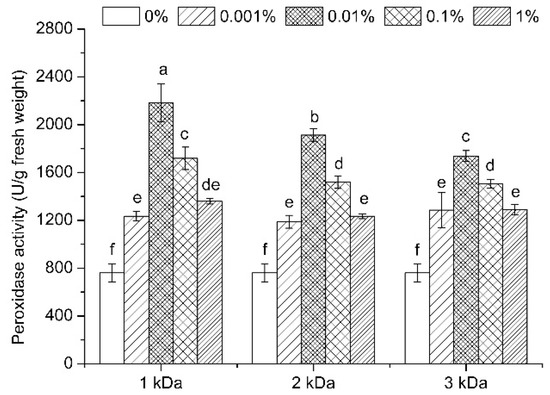
Figure 7.
Peroxidase activity of soybean sprouts under different chitooligosaccharide treatments. The treatments were conducted with chitooligosaccharides of three molecular weights (1, 2, and 3 kDa) at four different concentrations (0.001 to 1%). The control treatment (0%) included the same solutions without chitooligosaccharides. Vertical bars represent the standard error of three replicates. Different letters indicate statistically significant difference (p < 0.05).
Therefore, chitooligosaccharide treatment could enhance resistance to oxidative stress. Moreover, it also suggested that chitooligosaccharide could be recognized as an effective biotic elicitor, triggering a specific induction of catalase and peroxidase [43].
4. Conclusions
Chitooligosaccharide can significantly increase the content of phytochemicals and antioxidant properties of soybean sprouts. The highest accumulation of vitamin C, total phenolics, and total flavonoid occurred when the seeds were treated with 0.01% of 1 kDa chitooligosaccharide. Furthermore, the biosynthesis of nine phenolics and six isoflavones was also notably stimulated by chitooligosaccharide treatment. Moreover, the chitooligosaccharide strongly increased the antioxidant activities of soybean sprouts with the increase in the activities of catalase and peroxidase. The obtained data suggested that chitooligosaccharide could improve the physiological function of soybean sprouts by increasing their bioactive compounds content as well as antioxidant activity.
Author Contributions
Conceptualization, W.T. and F.Y.; methodology, W.T. and X.L. (Xinting Lei); validation, W.T., X.L. (Xinting Lei), and X.L. (Xiaoqi Liu); formal analysis, X.L. (Xiaoqi Liu); investigation, X.L. (Xinting Lei) and X.L. (Xiaoqi Liu); resources, W.T. and F.Y.; data curation, W.T. and F.Y.; writing—original draft preparation, W.T., X.L. (Xinting Lei), and X.L. (Xiaoqi Liu); writing—review and editing, W.T. and F.Y.; visualization, W.T., X.L. (Xinting Lei), and X.L. (Xiaoqi Liu); supervision, F.Y.; project administration, W.T. and F.Y.; funding acquisition, W.T. and F.Y. All authors have read and agreed to the published version of the manuscript.
Funding
This study was supported by Basic Research Projects of Liaoning Higher Education Institutions (2017J030) and Dalian High-level Talent Innovation Support Program (2018RQ24).
Institutional Review Board Statement
Not applicable.
Informed Consent Statement
Not applicable.
Data Availability Statement
Data is contained within the article.
Conflicts of Interest
No potential conflict of interest was reported by the authors.
References
- Xu, M.J.; Dong, J.F.; Zhu, M.Y. Effects of germination conditions on ascorbic acid level and yield of soybean sprouts. J. Sci. Food Agric. 2005, 85, 943–947. [Google Scholar] [CrossRef]
- Xu, B.J.; Chang, S.K. A comparative study on phenolic profiles and antioxidant activities of legumes as affected by extraction solvents. J. Food Sci. 2007, 72, 159–166. [Google Scholar] [CrossRef]
- Pilšáková, L.; Riečanský, I.; Jagla, F. The physiological actions of isoflavone phytoestrogens. Physiol. Res. 2010, 59, 651–664. [Google Scholar] [CrossRef]
- Khang, D.T.; Dung, T.N.; Elzaawely, A.A.; Xuan, T.D. Phenolic profiles and antioxidant activity of germinated legumes. Foods 2016, 5, 27–36. [Google Scholar] [CrossRef] [PubMed]
- Vidal-Valverde, C.; Frias, J.; Sierra, I.; Blazquez, I.; Lambein, F.; Kuo, Y.H. New functional legume foods by germination: Effect on the nutritive value of beans, lentils and peas. Eur. Food Res. Technol. 2002, 215, 472–477. [Google Scholar] [CrossRef]
- Shi, H.L.; Nam, P.K.; Ma, Y.F. Comprehensive Profiling of Isoflavones, Phytosterols, Tocopherols, Minerals, Crude Protein, Lipid, and Sugar during Soybean (Glycine max) Germination. J. Agric. Food Chem. 2010, 58, 4970–4976. [Google Scholar] [CrossRef] [PubMed]
- Plaza, L.; Ancos, B.D.; Cano, M.P. Nutritional and health-related compounds in sprouts and seeds of soybean (Glycine max), wheat (Triticum aestivum. L) and alfalfa (Medicago sativa) treated by a new drying method. Eur. Food Res. Technol. 2003, 216, 138–144. [Google Scholar] [CrossRef]
- Mastropasqua, L.; Dipierro, N.; Paciolla, C. Effects of Darkness and Light Spectra on Nutrients and Pigments in Radish, Soybean, Mung Bean and Pumpkin Sprouts. Antioxidants 2020, 9, 558. [Google Scholar] [CrossRef]
- Bau, H.M.; Villaume, C.; Nicolas, J.P.; Méjean, L. Effect of germination on chemical composition, biochemical constituents and antinutritional factors of soya bean (Glycine max) seeds. J. Sci. Food Agric. 1997, 73, 1–9. [Google Scholar] [CrossRef]
- Zhong, L.Y.; Niu, B.; Tang, L.; Chen, F.; Zhao, G.; Zhao, J.L. Effects of polysaccharide elicitors from endophytic Fusarium oxysporum Fat9 on the growth, flavonoid accumulation and antioxidant property of Fagopyrum tataricum sprout cultures. Molecules 2016, 21, 1590. [Google Scholar] [CrossRef] [PubMed] [Green Version]
- Mao, S.R.; Shuai, X.T.; Unger, F.; Simon, M.; Bi, D.Z.; Kissel, T. The depolymerization of chitosan: Effects on physicochemical and biological properties. Int. J. Pharm. 2004, 281, 45–54. [Google Scholar] [CrossRef]
- Shibuya, N.; Minami, E. Oligosaccharide signalling for defence responses in plant. Physiol. Mol. Plant Pathol. 2001, 59, 223–233. [Google Scholar] [CrossRef] [Green Version]
- No, H.K.; Lee, K.S.; Kim, I.D.; Park, M.J.; Kim, S.D.; Meters, S.P. Chitosan treatment affects yield, ascorbic acid content, and hardness of soybean sprouts. J. Food Sci. 2003, 68, 680–685. [Google Scholar] [CrossRef]
- No, H.K.; Kim, S.D.; Prinyawiwatkul, W.; Meyers, S.P. Growth of soybean sprouts affected by chitosans prepared under various deproteinization and demineralization times. J. Sci. Food Agric. 2006, 86, 1365–1370. [Google Scholar] [CrossRef]
- Lee, Y.S.; Kim, Y.H.; Kim, S.B. Changes in the respiration, growth, and vitamin C content of soybean sprouts in response to chitosan of different molecular weights. HortScience 2005, 40, 1333–1335. [Google Scholar] [CrossRef] [Green Version]
- Rui, Y.; Yu, J.; Xiu, L.; Huang, J. Effect of chitosan pre-soaking on the growth and quality of yellow soybean sprouts. J. Sci. Food Agric. 2019, 99, 1596–1603. [Google Scholar]
- Lan, W.Q.; Wang, W.; Yu, Z.M.; Qin, Y.X.; Luan, J.; Li, X.Z. Enhanced germination of barley (Hordeum vulgare L.) using chitooligosaccharide as an elicitor in seed priming to improve malt quality. Biotechnol. Lett. 2016, 38, 1935–1940. [Google Scholar] [CrossRef]
- Kim, S.K.; Rajapakse, N. Enzymatic production and biological activities of chitosan oligosaccharides (COS): A review. Carbohydr. Polym. 2005, 62, 357–368. [Google Scholar] [CrossRef]
- Wang, J.H.; Ye, Y.T.; Li, Q.; Abbasi, A.M.; Guo, X.B. Assessment of phytochemicals, enzymatic and antioxidant activities in germinated mung bean (Vigna radiata L. Wilezek). Int. J. Food Sci. Technol. 2017, 52, 1276–1282. [Google Scholar] [CrossRef]
- Yang, F.; Luan, B.; Sun, Z.; Yang, C.; Yu, Z.M.; Li, X.Z. Application of chitooligosaccharides as antioxidants in beer to improve the flavour stability by protecting against beer staling during storage. Biotechnol. Lett. 2016, 39, 305–310. [Google Scholar] [CrossRef]
- Zhang, S.; Tang, W.Z.; Jiang, L.L.; Hou, Y.M.; Yang, F.; Chen, W.F.; Li, X.Z. Elicitor activity of algino-oligosaccharide and its potential application in protection of rice plant (Oryza saliva L.) against Magnaporthe grisea. Biotechnol. Biotechnol. Equip. 2015, 29, 646–652. [Google Scholar] [CrossRef] [Green Version]
- Hamel, L.P.; Beaudoin, N. Chitooligosaccharide sensing and downstream signaling: Contrasted outcomes in pathogenic and beneficial plant-microbe interaction. Planta 2010, 232, 787–806. [Google Scholar] [CrossRef]
- Kulikov, S.N.; Chirkov, S.N.; Il’ina, A.V.; Lopatin, S.A.; Varlamov, V.P. Effect of the molecular weight of chitosan on its antiviral activity in plants. Appl. Biochem. Microbiol. 2006, 42, 200–203. [Google Scholar] [CrossRef]
- Mendoza-Sanchez, M.; Guevara-Gonzalez, R.G.; Castano-Tostado, E.; Mercado-Silva, E.M.; Acosta-Gallegos, J.A.; Rocha-Guzman, N.E. Effect of chemical stress on germination of cv Dalia bean (Phaseolus vularis L.) as an alternative to increase antioxidant and nutraceutical compounds in sprouts. Food Chem. 2016, 212, 128–137. [Google Scholar] [CrossRef] [PubMed]
- Liu, H.K.; Cao, Y.; Huang, W.N.; Guo, Y.D.; Kang, Y.F. Effect of ethylene on total phenolics, antioxidant activity, and the activity of metabolic enzymes in mung bean sprouts. Eur. Food Res. Technol. 2013, 237, 755–764. [Google Scholar] [CrossRef]
- Kumari, S.; Krishnan, V.; Sachdev, A. Impact of soaking and germination durations on antioxidants and anti-nutrients of black and yellow soybean (Glycine max. L.) varieties. J. Plant Biochem. Biotechnol. 2015, 24, 355–358. [Google Scholar] [CrossRef]
- Guo, X.B.; Li, T.; Tang, K.X.; Liu, R.H. Effect of germination on phytochemical profiles and antioxidant activity of mung bean sprouts (Vigna radiata). J. Agric. Food Chem. 2012, 60, 11050–11055. [Google Scholar] [CrossRef] [PubMed]
- Jiratanan, T.; Liu, R.H. Antioxidant activity of processed table beets (Beta vulgaris var, conditiva) and green beans (Phaseolus vulgaris L.). J. Agric. Food Chem. 2004, 52, 2659–2670. [Google Scholar] [CrossRef] [PubMed]
- Ramirez-Estrada, K.; Vidal-Limon, H.; Hidalgo, D.; Moyano, E.; Golenioswki, M.; Cusidó, R.M.; Palazon, J. Elicitation, an effective strategy for the biotechnological production of bioactive high-added value compounds in plant cell factories. Molecules 2016, 21, 182. [Google Scholar] [CrossRef]
- Kim, E.H.; Kim, S.H.; Chung, J.I.; Chi, H.Y.; Kim, J.A.; Chung, I.M. Analysis of phenolic compounds and isoflavones in soybean seeds (Glycine max (L.) Merill) and sprouts grown under different conditions. Eur. Food Res. Technol. 2006, 222, 201. [Google Scholar] [CrossRef]
- Lee, A.H.; Su, D.D.; Pasalich, M.; Tang, L.; Binns, C.W.; Qiu, L.Q. Soy and isoflavone intake associated with reduced risk of ovarian cancer in southern Chinese women. Nutr. Res. 2014, 34, 302–307. [Google Scholar] [CrossRef] [Green Version]
- Al-Tawaha, A.M.; Seguin, P.; Smith, D.L.; Beaulieu, C. Biotic elicitors as a means of increasing isoflavone concentration of soybean seeds. Ann. Appl. Biol. 2005, 146, 303–310. [Google Scholar] [CrossRef]
- Chen, Y.M.; Chang, S.K.C. Macronutrients, phytochemicals, and antioxidant activity of soybean sprout germinated with or without light exposure. J. Food Sci. 2015, 80, 1391–1398. [Google Scholar] [CrossRef]
- Dixon, R.A.; Paiva, N.L. Stress-induced phenylpropanoid metabolism. Plant Cell 1995, 7, 1085–1097. [Google Scholar] [CrossRef] [PubMed]
- Algar, E.; Ramos-Solano, B.; García-Villaraco, A.; Sierra, M.D.S.; Gómez, M.S.M.; Gutiérrez-Mañero, F.J. Bacterialbioeffectors modify bioactive profile and increase isoflavone content in soybean sprouts (Glycine max var Osumi). Plant Foods Hum. Nutr. 2013, 68, 299–305. [Google Scholar] [CrossRef]
- Molyneux, P. The use of the stable free radical diphenylpicrylhydrazyl (DPPH) for estimating antioxidant activity. Songklanakarin J. Sci. Technol. 2004, 26, 211–219. [Google Scholar]
- Yun, J.; Li, X.H.; Fan, X.T.; Li, W.L.; Jiang, Y.Q. Growth and quality of soybean sprouts (Glycine max L. Merrill) as affected by gamma irradiation. Radiat. Phys. Chem. 2013, 82, 106–111. [Google Scholar] [CrossRef]
- Zou, P.; Li, K.C.; Liu, S.; Xing, R.E.; Qin, Y.K.; Yu, H.H.; Zhou, M.M.; Li, P.C. Effect of chitooligosaccharides with different degrees of acetylation on wheat seedlings under salt stress. Carbohydr. Polym. 2015, 126, 62–69. [Google Scholar] [CrossRef]
- Smirnoff, N.; Cumbes, Q.J. Hydroxyl radical scavenging activity of compatible solutes. Phytochemistry 1988, 28, 1057–1060. [Google Scholar] [CrossRef]
- Chung, S.K.; Osawa, T.; Kawakishi, S. Hydroxyl radical-scavenging effects of spices and scavengers from brown mustard (Brassica nigra). Biosci. Biotechnol. Biochem. 1997, 61, 118–123. [Google Scholar] [CrossRef] [Green Version]
- Liu, J.; Tian, S.P.; Meng, X.H.; Xu, Y. Effects of chitosan on control of postharvest diseases and physiological responses of tomato fruit. Postharvest Biol. Technol. 2007, 44, 300–306. [Google Scholar] [CrossRef]
- Syeed, S.; Khan, N.A. Activities of carbonic anhydrase, catalase and ACC oxidase of mung bean (Vigna radiata) are differentially affected by salinity stress. J. Food Agric. Environ. 2004, 2, 241–249. [Google Scholar]
- Day, R.B.; Okada, M.; Ito, Y.; Tsukada, K.; Zaghouani, H.; Shibuya, N.; Stacey, G. Binding site for chitin oligosaccharides in the soybean plasma membrane. Plant Physiol. 2001, 126, 1162–1173. [Google Scholar] [CrossRef] [PubMed] [Green Version]
Publisher’s Note: MDPI stays neutral with regard to jurisdictional claims in published maps and institutional affiliations. |
© 2021 by the authors. Licensee MDPI, Basel, Switzerland. This article is an open access article distributed under the terms and conditions of the Creative Commons Attribution (CC BY) license (https://creativecommons.org/licenses/by/4.0/).